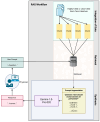From Data to Decisions: Leveraging Retrieval-Augmented Generation to Balance Citation Bias in Burn Management Literature
- PMID: 40558623
- PMCID: PMC12191722
- DOI: 10.3390/ebj6020028
From Data to Decisions: Leveraging Retrieval-Augmented Generation to Balance Citation Bias in Burn Management Literature
Abstract
(1) Burn injuries demand multidisciplinary, evidence-based care, yet the extensive literature complicates timely decision making. Retrieval-augmented generation (RAG) synthesizes research while addressing inaccuracies in pretrained models. However, citation bias in sourcing for RAG often prioritizes highly cited studies, overlooking less-cited but valuable research. This study examines RAG's performance in burn management, comparing citation levels to enhance evidence synthesis, reduce selection bias, and guide decisions. (2) Two burn management datasets were assembled: 30 highly cited (mean: 303) and 30 less-cited (mean: 21). The Gemini-1.0-Pro-002 RAG model addressed 30 questions, ranging from foundational principles to advanced surgical approaches. Responses were evaluated for accuracy (5-point scale), readability (Flesch-Kincaid metrics), and response time with Wilcoxon rank sum tests (p < 0.05). (3) RAG achieved comparable accuracy (4.6 vs. 4.2, p = 0.49), readability (Flesch Reading Ease: 42.8 vs. 46.5, p = 0.26; Grade Level: 9.9 vs. 9.5, p = 0.29), and response time (2.8 vs. 2.5 s, p = 0.39) for the highly and less-cited datasets. (4) Less-cited research performed similarly to highly cited sources. This equivalence broadens clinicians' access to novel, diverse insights without sacrificing quality. As plastic surgery evolves, RAG's inclusive approach fosters innovation, improves patient care, and reduces cognitive burden by integrating underutilized studies. Embracing RAG could propel the field toward dynamic, forward-thinking care.
Keywords: AI (artificial intelligence); RAG (retrieval-augmented generation); burn; clinical decision support; large language model; plastic surgery.
Conflict of interest statement
The authors declare no conflicts of interest.
Figures
Similar articles
-
Enhancing the Readability of Online Patient Education Materials Using Large Language Models: Cross-Sectional Study.J Med Internet Res. 2025 Jun 4;27:e69955. doi: 10.2196/69955. J Med Internet Res. 2025. PMID: 40465378 Free PMC article.
-
Predicting 30-Day Postoperative Mortality and American Society of Anesthesiologists Physical Status Using Retrieval-Augmented Large Language Models: Development and Validation Study.J Med Internet Res. 2025 Jun 3;27:e75052. doi: 10.2196/75052. J Med Internet Res. 2025. PMID: 40460423 Free PMC article.
-
Magnetic resonance perfusion for differentiating low-grade from high-grade gliomas at first presentation.Cochrane Database Syst Rev. 2018 Jan 22;1(1):CD011551. doi: 10.1002/14651858.CD011551.pub2. Cochrane Database Syst Rev. 2018. PMID: 29357120 Free PMC article.
-
Enhancing Pulmonary Disease Prediction Using Large Language Models With Feature Summarization and Hybrid Retrieval-Augmented Generation: Multicenter Methodological Study Based on Radiology Report.J Med Internet Res. 2025 Jun 11;27:e72638. doi: 10.2196/72638. J Med Internet Res. 2025. PMID: 40499132 Free PMC article.
-
The clinical effectiveness and cost-effectiveness of technologies used to visualise the seizure focus in people with refractory epilepsy being considered for surgery: a systematic review and decision-analytical model.Health Technol Assess. 2012;16(34):1-157, iii-iv. doi: 10.3310/hta16340. Health Technol Assess. 2012. PMID: 22985954
References
-
- American Burn Association Burn Incidence Fact Sheet. 2024. [(accessed on 14 December 2024)]. Available online: https://ameriburn.org/resources/burn-incidence-fact-sheet.
-
- Johnson C. Management of burns. Surgery. 2018;36:435–440. doi: 10.1016/j.mpsur.2018.05.004. - DOI
LinkOut - more resources
Full Text Sources
Research Materials


